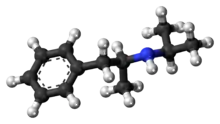 | |
 | |
| Clinical data | |
|---|---|
| Other names | N-isopropylamphetamine |
| ATC code |
|
| Identifiers | |
| |
| CAS Number | |
| PubChem CID | |
| ChemSpider | |
| UNII | |
| ChEMBL | |
| CompTox Dashboard (EPA) | |
| Chemical and physical data | |
| Formula | C12H19N |
| Molar mass | 177.291 g·mol−1 |
| 3D model (JSmol) | |
| |
| |
| (verify) | |
Isopropylamphetamine is a psychostimulant of the substituted amphetamine class.[1] It is an isomer of propylamphetamine and was discovered by a team at Astra Laekemedel AB.[2] The isopropyl moiety reduces the stimulant activity of the compound but greatly increases the duration of action. For this reason, the compound is not used recreationally.
See also
References
- ↑ Testa B, Salvesen B (May 1980). "Quantitative structure-activity relationships in drug metabolism and disposition: pharmacokinetics of N-substituted amphetamines in humans". Journal of Pharmaceutical Sciences. 69 (5): 497–501. doi:10.1002/jps.2600690505. PMID 7381729.
- ↑ CA 1073913, Florvall GL, Ross SB, Öegren SO, "Amphetamine Derivatives", issued 18 April 1980, assigned to Astra Läkemedl AB
This article is issued from Wikipedia. The text is licensed under Creative Commons - Attribution - Sharealike. Additional terms may apply for the media files.